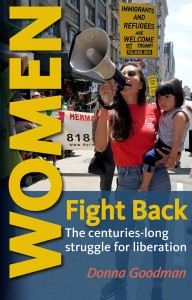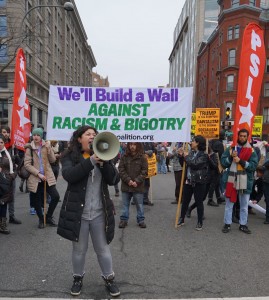 Welcome to the study and discussion guide for Women Fight Back: The Centuries-Long Struggle for Liberation. Below you will find a list of questions for consideration and dialogue as you read through this new PSL publication (which can be purchased here).
Welcome to the study and discussion guide for Women Fight Back: The Centuries-Long Struggle for Liberation. Below you will find a list of questions for consideration and dialogue as you read through this new PSL publication (which can be purchased here).
These questions are meant to help guide you as you study the book individually or, hopefully, collectively. If you are interested in joining or forming a study group, the educational workers at Liberation School would be happy to help! Let us know!
Preface
- How does the author explain why the book was written?
- What three words would you use to describe the historical context for the book?
- What has moved you to read the book?
- What forces are at play in the current moment, and what is the role of the Democratic Party? Do you agree?
Introduction
- How does the author situate the movement for women’s liberation within the context of the founding of the US capitalist system based upon slave labor?
- How should we understand the major advances in women’s rights over the past 226 years?
- What similarities and differences exist between second wave feminism and third wave feminism? What does this matter for today’s women’s movement?
- What does Goodman mean by a “conservative backlash,” and how should we fight back?
- Think of at least two different women’s organizations operating today—in your town/city, in the U.S., or in the world—and describe if and how they are resisting the conservative backlash.
Chapter 1
- What are some reasons that the contemporary women’s movement doesn’t focus on capitalism?
- What does the wage gap tell us about the relationship between capitalism and the oppression of women?
- The chapter describes myriad ways that women are subjugated under capitalism. How have you seen these play out in your own life?
- How did President Bill Clinton begin to dramatically shred the social safety net women has fought so hard for?
- Discuss the material results on women’s lives of the dismantling of the safety net.
- What different kinds of violence are women in capitalism subjected to?
Chapter 2
- Why does Marxism reject the idea that women are biologically inferior to men? If human nature doesn’t explain the oppression of women, what does?
- What contributions did Engels make to the understanding of women’s oppression?
- What assumptions did Engels make that were later corrected?
- Why is it important to acknowledge that women have not always been oppressed by men?
- Think back to your early childhood: What were the first ideas you got about women? From whom did you get those ideas? How have your ideas about women changed over time?
Chapter 3
- What concrete advancements were made for women as a result of the Bolshevik Revolution?
- How did the fall of the Soviet Union impact women?
- How did the role of women in China shift after the Chinese Revolution?
- What was the significance of the Cultural Revolution in China?
- What were the consequences for women after the death of Mao?
- How did the Cuban Revolution advance women’s liberation? Discuss its impacts both inside of Cuba and internationally.
- After reading this chapter, what lessons can we draw about the relationship between socialism and women’s liberation? What questions do you still have?
Chapter 4
- Discuss the first wave of feminism, or the struggle for women’s rights in the nineteenth century.
- What were the primary obstacles this movement faced?
- What is the connection between the abolitionist and women’s movements?
- What issues led to a split in the movement after the Civil War? Are any of these issues still with us today?
- What connections and contradictions existed between the labor movement and the movement for women’s rights?
Chapter 5
- What new dynamics emerged in the movement for women’s rights in the twentieth century?
- What happened to the suffrage movement after the passage of the 15th Amendment?
- What forces were lined up against the suffrage movement and why?
- How did capital’s changing labor needs impact and intertwine with the women’s and the socialist movements?
- What are the historical connection between eugenics, birth control, and the women’s movement? Why is this significant for the contemporary struggle?
- How can today’s labor movement take women’s liberation into account more fully?
- Discuss the complexities involving the fight back against gender-based violence and rape.
Chapter 6
- How did WWII affect the feminist uprising?
- What were the dominant ideas about gender during this period?
- What impact did the anti-communist witch-hunt have on the women’s movement?
- In what ways did the communist movement support and extend the movement for women’s rights?
Chapter 7
- How would you characterize the difference between the first wave women’s movement and second wave feminism?
- What is liberal feminism and its organizations and projects?
- What is radical feminism and its larger significance in the social movement scene?
- What distinguishes socialist and Marxist feminism from liberal and radical feminism?
- Discuss the significance of Black, Asian American, Latina, Lesbian and Labor feminisms.
- What is significant about the vast array of feminism tendencies outlined in this chapter?
- How did these different tendencies build on or ignore the work of Engels that was discussed in chapter 2?
Chapter 8
- What gains did second wave feminism win? How did these impact different groups of women?
- What is the difference between “reproductive rights” and “reproductive justice?”
- How have the reforms won during this period touched your life?
- What is the significance of cultural transformations in gender roles?
- What tactics and actions were successful during this period of struggle? Are they still relevant today?
Chapter 9
- What forces worked to undermine and roll back gains made in the movement for women’s rights?
- How did the collapse of the Soviet Union impact the women’s movement in the US?
- What impact has neoliberal capitalism had on the conditions of women’s lives and the movement for women’s rights?
- What advances were most negatively impacted in the backlash?
- Were all groups of women similarly affected by this roll back? Why or why not?
Chapter 10
- What impact have NGOs had on the struggle for women’s rights since the 1990s?
- How has left-wing feminism been revived in the 21st century?
- Discuss the “galvanizing event” in the 1990s that sparked a rebirth in the women’s rights movement.
- How does third wave feminism differ from first and second wave feminism? Think of at least three differences.
- What is “postmodernism,” and how has it altered the women’s movement?
- Discuss the various versions of the concept of “intersectionality.” How have they transformed feminism?
- How has third wave feminism taken on struggles against gender-based violence, racism, and capitalist exploitation?
- Discuss the growing significance of LGBTQ and trans rights within third wave feminism.
Chapter 11
- What dangers does the Trump regime pose for women’s rights? Have you seen any effects in your own life or the life of women you know?
- What type of feminism is required to meet these serious dangers?
- What have been some of the more noteworthy feminist responses to the Trump agenda?
- What has the response to the Trump presidency taught us about what is possible in this new era of reaction?
- What does the failure of the Clinton campaign suggest about the resistance movement?
- What kind of politics and political organization do we need for women’s liberation?
